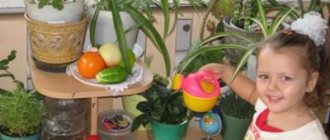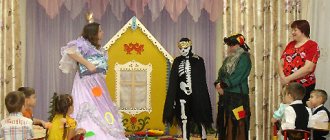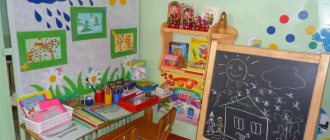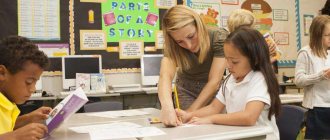Organization of an entertaining mathematics center in a group
- September 3, 2017
International and All-Russian competitions
All-Russian competition “Portfolio of a teacher of a preschool educational institution”
Mathematics plays a huge role in mental education and in the development of intelligence. Its study contributes to the development of memory, speech, imagination, emotions; forms perseverance, patience, and creative potential of the individual.
The main goal of doing mathematics is to give the child a sense of self-confidence, based on the fact that the world is orderly and therefore understandable, and therefore predictable for humans. Mathematics has a unique developmental effect. “Mathematics is the queen of all sciences! She puts her mind in order!
Having studied the literature on pedagogy, I came to the conclusion that the maximum effect with FEMP can be achieved using didactic games, entertaining exercises, tasks and entertainment. Therefore, for an in-depth study, I chose the topic: “FEMP through educational games.”
Working on this topic, I set myself a goal: to organize work on FEMP for preschool children in accordance with modern requirements using educational games to develop memory, attention, imagination, and logical thinking.
In accordance with the Federal State Educational Standard, my task is to develop creative cognitive activity in children. A condition for the successful implementation of this task is the organization of a subject-development environment in the senior group. The developmental environment, in accordance with the Federal State Educational Standard, must be content-rich, transformable, variable, accessible and, of course, safe.
I try to organize the developmental environment in our group in such a way as to provide the opportunity to most effectively develop the individuality of each child, taking into account his inclinations, interests, and level of activity.
For the child’s mathematical activity, I created conditions under which he would show independence in choosing gaming material, games, based on his developing needs and interests. During the game, which arises on the initiative of the child himself, he becomes involved in complex intellectual work.
I consider the teacher’s selection of games, toys, and play equipment to be an important condition in organizing a developmental environment. The saturation of the subject-developmental environment should be reasonable. Games should be appropriate to the age of the children and the tasks that are being solved at this stage. Shelves should not be cluttered with excess material.
The teacher needs to promptly change the subject-game environment through new attributes, games, toys, and gaming equipment in accordance with the new content of the games. Of course, the accessibility of the content of the subject-development environment for children is also important: games, toys, and various gaming attributes should be located no higher than the child’s outstretched arm.
Goal: organizing work on FEMP for preschool children in accordance with modern requirements using educational games.
When creating a math corner for older children, I solved the following problems :
- Purposefully develop children's interest in elementary mathematical activities.
- To develop the qualities and personality traits of the child necessary for successful mastery of mathematics in the future: purposefulness and expediency of search actions, the desire to achieve a positive result, perseverance and resourcefulness, independence.
- To instill in children the need to occupy their free time not only with entertaining games, but also with games that require mental stress and intellectual effort. Entertaining mathematical material in preschool and subsequent years should become a means of organizing useful leisure time and promoting the development of creativity.
The success of play activities in a corner organized in a group is determined by the interest of the teacher himself in entertaining tasks for children. The teacher must have knowledge about the nature, purpose, developmental impact of entertaining material, and techniques for guiding independent activity with elementary mathematical material. The interest and passion of the teacher is the basis for children to show interest in mathematical problems and games.
When creating a mathematical corner, I tried to clearly reflect those areas of FEMP (familiarity with size, quantity, orientation in space, time, shape) through the use of thematic dolls. Didactic games were also selected according to the directions .
For example, for quantity : n/game “Learning about counting”, d/i “Counting with Mowgli”, “Arithmetic”, “Counting little niggas”, “My first numbers”, “Entertaining numbers”, “Funny numbers”, “Math cubes” ", "Find a neighbor", "Mathematics", "Let's play and count", "Mathematical lotto", "Loto numbers", "Feed the fish", "Number houses", pictures "Make up a problem", dominoes.
By size : “Balls”, “Christmas trees”, “Sticks in a row”, “Who will roll the ribbon faster”, “Fold the boards”, pictures “Size of objects”.
On the form : “Geometric shapes”, “Color and shape”, Lotto “Colors and shapes”, “Tricky objects”, “Finish the row”, “Collect the figures”, “The fourth odd one”, “Fun logic”, “Logical dominoes” , dominoes “Learning shapes and colors”, wonderful bag.
For time : “Parts of the day”, “Time”, “First hours”, Seasons”, models “Parts of the day” and “Days of the week”.
For orientation in space : “Tell me about your pattern”, “Find a paired picture”, “Sun”, “Preschooler’s folders: “Orientation in space”, “Labyrinth”, “Orientation by cells”.
The creation of a corner is preceded by the selection of gaming material, which is determined by the age capabilities and level of development of the children in the group. A variety of entertaining material is placed in the corner so that each child can choose a game for themselves.
These are board and printed games, games for the development of logical thinking, leading children to master checkers and chess, puzzles; logic problems and cubes, labyrinths; games for composing a whole from parts, for recreating silhouette figures from special sets of figures; movement games. They are all interesting and entertaining.
When organizing an entertaining mathematics corner, I proceed from the principles of games being accessible to children at the moment, and place in the corner such games and gaming materials that children can master at different levels.
From mastering the given rules and game actions, they move on to inventing new game options. There are great opportunities for creativity in the “Cubes for Everyone” games: “Unicube”, “Nikitin’s Cubes”, Montessori inserts, Nikitin’s Square, Nikitin’s dots, Geometric tablet, Cuisenaire sticks, Dienesh blocks.
The essence of these games is to recreate on a plane the silhouettes of objects, animals, birds, people in an image or design. Children can come up with new, more complex silhouettes not only from one, but also from 2 - 3 sets for the game; one and the same silhouette, for example, a fox, can be composed of different sets. For a long time, these puzzles were used to entertain adults and teenagers, but modern research has proven that they are an effective means of mental, particularly mathematical, development of preschoolers.
Counting sticks have traditionally been used as a counting material. However, their diverse design capabilities make it possible to form geometric concepts in children and develop spatial imagination. Games with counting sticks create great opportunities for developing not only ingenuity and ingenuity, but also through the discovery of new ways of acting with material, activity and independence.
Our group has created, which includes:
- sets of counting materials and a fan of numbers for each child,
- sets of three-dimensional geometric shapes of different sizes (large wooden construction set "Polikarpova", small colored wooden construction set,
- entertaining and educational didactic games,
- multifunctional educational aids “Clock”, “Locomotive from Romashkovo”, panel “Travel through Time”, mathematical tablet “Geometric”,
- watches: with dial and hourglass,
- various toys with laces and “Turtle” fasteners,
- colored paper clips.
In the group, children play “Shop” using coins to consolidate knowledge about coins with denominations of 1, 5, 10 kopecks, 1, 2, 5, 10 rubles (discrimination, selection and exchange of coins); to the “Barbershop”, in which girls measure ribbons by length (to strengthen the ability to measure the width and height of objects, that is, straight line segments); in “Kitchen” to strengthen children’s ability to measure the volume of liquid and granular substances using a conventional measure).
Thus, our subject-development environment in the group helps to consolidate children’s knowledge, enrich their social experience, and develop children’s creativity. It gives us teachers the opportunity to implement a person-centered approach, and also helps to unlock the creative potential of the teacher and children.
Design of a math corner in the second middle group
ANNA Bruder
Design of a math corner in the second middle group
The Fun Math corner is a specially designated place, thematically equipped with games, manuals and materials , and in a certain way artistically decorated .
Basic requirements for the fun math corner:
the corner should be a specially designated area;
it is necessary to ensure free access to it for children;
The contents of the corner should , on the one hand, be familiar to the child, on the other hand, the materials should be constantly changing and supplemented.
All materials must be colorfully designed .
Our kids really enjoyed the math corner
math lapbook looks like .
The children really enjoyed playing with Dienesh's Logic Blocks
Design of a music corner in the second junior group of a preschool educational institution according to the Federal State Educational Standard. For the development of children's independent musical activity, the music corner in the group (music zone) is very important. Decorating a book corner in the middle group I present to your attention how you can decorate a book corner in the middle group. This is a continuation of my conversation about the design of subject development. Design of a math corner in the second junior group. When designing the “Entertaining Mathematics Corner” in the second junior group, we were guided by the following tasks: 1. Development of qualities. Design of a mathematical corner in the second junior group Objectives: Children’s mastery of the ability to use standard shapes: ball, cube, circle, square, rectangle, triangle; mastering simple connections. Design of a sensory corner in the middle group A child’s sensory development is the development of his perception and the formation of ideas about the external properties of objects: size, shape, color. Decorating a theater corner in the middle group In our kindergarten, a competition was announced for the best theater corner. All teachers took part with pleasure. I felt the same way. Design of a corner for studying traffic rules in the middle group Good evening, dear colleagues! Today I want to share with you ideas for decorating our safety corner. There is safety in our kindergarten. Decorating a corner of nature in spring in the middle group Hello dear colleagues. I would like to bring to your attention the design of a corner of “Nature” in the spring season. It started at the end of March. Decorating a nature corner in the second junior group of a kindergarten. Our group has a nature corner. The purpose of the corner: to create conditions for the development of children’s cognitive activity. Objectives: to develop in children. Design of a corner for the development of speech and fiction in the second junior group The level of speech development is an important indicator of the child’s mental state. Mastery of speech is the key to successful acquisition of knowledge.Source






